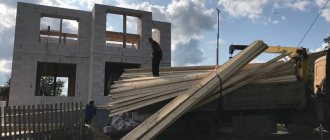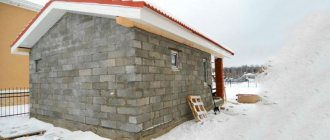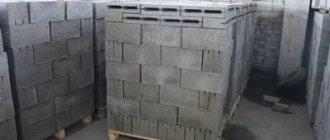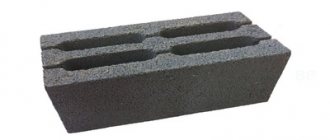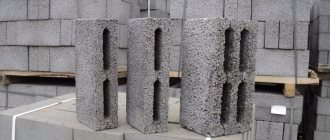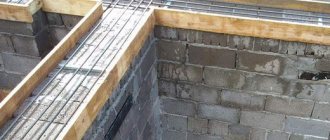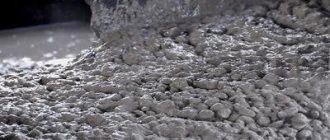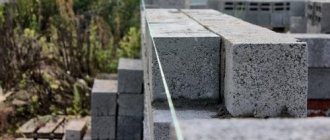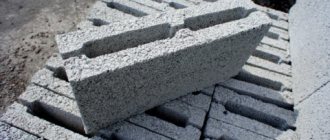Gas block calculator
provides the user with an accurate calculation of the number of aerated concrete blocks for the construction of walls and partitions of the house. The program allows you to find out the quantity, volume, weight, cost of building materials, as well as the consumption of masonry mortar and mesh for the construction of a reliable structure. Using additional fields, you can take into account the presence of doors, windows, gables and other elements.
Information on the technical characteristics of the blocks is taken from the relevant GOST and manufacturers' reference books. To get the result, fill in the fields of the calculator and click the “Calculate” button.
Size and dimension
Under a microscope, he discovered that a flea lives on a flea, a flea bites; On that flea there is a tiny flea, and the little flea angrily sticks its tooth into the flea, and so on ad infinitum.
What is the difference between length, area and volume? [edit]
We all know that it is impossible to add together quantities measured in different units. Not everyone, however, understands why. It seems that length, area, and volume are measured in meters, but in one case the meter is linear, in another it is square, and in the third it is cubic. What difference does it really make to us?
The difference appears if we want to move from meters to centimeters.
1 m = 100 cm = 100 1 cm 1,
1 sq. m = 1 m 2 = 1 m × 1 m = 100 cm × 100 cm = 10,000 cm × cm = 100 2 cm 2,
1 cu. m. = 1 m 3 = 1 m × 1 m × 1 m = 100 cm × 100 cm × 100 cm = 1,000,000 cm × cm × cm = 100 3 cm 3.
If we add square meters to linear ones, then it will not be clear how the result will be measured, which means it will not be clear by what number to multiply the answer when moving from meters to centimeters. This means that you cannot add length and area.
It is not necessary to change the unit of length exactly a hundred times.
When the unit of length changes by a factor of 3, the unit of area will change by 3 2 = 3 ⋅ 3 = 9 =3cdot 3=9> times, and the unit of volume will change by 3 3 = 3 ⋅ 3 ⋅ 3 = 27 =3cdot 3cdot 3=27> times. Thus, we can “disassemble” a large segment into 3 1 > segments 3 times smaller in length, a large square into 3 2 > squares 3 times smaller in linear dimensions, a large cube into 3 3 > cubes 3 times smaller in linear dimensions . In all of the above cases, we “disassemble” the figure into a set of smaller figures of equal size, similar to the large figure. The power to which a change in linear scale is raised is called dimension. Thus, a segment is one-dimensional, a square is two-dimensional, and a cube is three-dimensional.
Using the calculator
Using an online calculator to calculate materials for a house makes sense only when the building has the correct geometric shape in plan and one floor. Most services are so primitive that they do not take into account the size of the openings, the presence of partitions, much less gables of a complex configuration - so getting an accurate calculation will be quite problematic.
Sergey Yurievich
Construction of houses, extensions, terraces and verandas.
Ask a Question
To check the consistency of the two calculations, we found a service on the Internet that takes all this into account and entered the requested data. The result we received exceeded the result of manual calculation by almost 10 cubic meters.
Considering that at the beginning of autumn 2022 the cost of autoclaved gas blocks reaches 9,500 rubles, it is not difficult to calculate how much money would have to be overpaid. The only conclusion we can draw is this: it’s better to spend a little time, but calculate the amount of material yourself. How many pallets are needed?
Aerated blocks are sold in factory packaging; no one unseals them before they arrive at the facility. The blocks are stacked on pallets, which, depending on their width and length, have a certain loading rate.
The norm is indicated approximately; the exact amount of aerated concrete placed on pallets also depends on the format of the blocks. For example, the average capacity of a standard 1200*1000 mm pallet is 1.875 m3. However, blocks of size 625*250*200 or 625*250*400 fit 1.992 m3, and blocks 600*250*300 mm - 2.16 m3.
A Euro pallet has a smaller size than a standard one: 800*1200 mm - and, accordingly, the loading rate is smaller (on average it is 1,406 m3). To find out how many pallets you need to purchase, divide the calculated cubic capacity of the walls by the load-carrying capacity of one pallet and round the total up: 51.44 m3: 1.92 m3 = 27 pallets.
Price of aerated blocks with quadrature calculation
Each customer wants to know in advance the amount he will have to pay when purchasing the material. To do this, you need to decide not only on the size of the blocks, but also on their manufacturer and the offered price. For example, let’s calculate a gas block for 100 sq.m of walls.
Let's say you decide to take blocks 250*600*375 mm at a price of 3,500 rubles per cubic meter. Knowing the square footage of the wall, it needs to be multiplied by the thickness of the masonry (in this case it is 375 mm), and you will get the cubic size of the walls. 100 m2*0.375 m =37.5 m3. Multiply by the price, we get 37.5 m3*3500 rub.=131250 rub./m3
Online calculation of the walls of a house made of aerated concrete blocks
If this calculator was useful to you, please click on one or more social buttons. Thank you for your great contribution in supporting our project. We wish you good health, happiness, success in your professional activities and further prosperity of your business. Thanks a lot.
Maybe you will be interested?
Brick is an artificial stone, made in the form of bars, formed from mineral materials (mainly from clay and various additives to it) and acquiring stone-like properties. Read completely
In this article we will talk about heat-resistant paints and their areas of application.. Read more
This guide outlines the procedure for calculating a heated floor using our calculator and describes some of the principles of constructing a heated floor. Read completely
Information on the purpose of aerated concrete blocks
A fairly new and popular material, aerated concrete is a lightweight cellular concrete, which is obtained by mixing quartz sand, lime, Portland cement and aluminum powder, which in turn gives rise to gas formation. You can learn more about aerated concrete, its pros and cons in this article.
Aerated concrete blocks are used for:
- Thermal insulation of enclosing structures;
- Construction of enclosing structures;
- Construction of interior partitions.
The use of aerated concrete directly depends on its density; in the marking it is indicated by the symbol “D”.
It is generally accepted that at D=300-500 the blocks are thermally insulating.
When D=500-900 structural and thermal insulation blocks
When D is over 900, structural blocks.
As a rule, for the construction of load-bearing walls of a residential building, aerated concrete blocks with a density of 500-600 are used, thereby achieving the necessary load-bearing capacity of the wall, the desired thermal insulation properties and saving costs on building a house.
How many blocks are needed for a house: calculation method based on a real example
When preparing to purchase materials, a competent developer makes an accurate calculation of their quantity.
Without this work, it is impossible to estimate upcoming costs and plan the overall construction budget. In this article we will look at options for calculating the number of blocks needed to build walls. We hope that our method will help beginners to accurately calculate the final figures in pieces and cubes, taking into account losses that occur during transportation and laying.
The content of the article:
Starting with the simplest example - building a garage, we will answer a more complex question - how many blocks are needed for a house. The internal walls and partitions of a residential building, the size of the masonry stone, as well as other factors affecting the amount of purchased materials will not go without our attention.
How many centimeters in a square meter
to find out how many centimeters are in a square meter .
First, let's remember what a square meter is and how it is calculated.
The square meter in the International System of Units is a unit of area. One square meter is a square with a side length of 1 meter. The area of such a square is 1 square meter:
S = 1 meter x 1 meter = 1 square meter
How to calculate how many cm are in a square meter ? One meter corresponds to 100 centimeters. Instead of meters, we substitute in our formula the same parameters, but in centimeters, that is, a meter expressed in centimeters:
S = 100 cm x 100 cm = 10,000 sq. cm
Another calculation method looks like this:
1m2 = 100 cm2 = 100 x100 = 10,000 cm2
For reference: The International System of Units is the system for measuring physical quantities that is most widespread in the world. As for the definition of meter, the meter refers to the basic units of physical quantities in this system. A meter is a unit of measurement for length and distance. According to this particular system, it is accepted that there are 100 centimeters in a meter. This is exactly what the calculation was based on - converting square meters into centimeters.
Igor Voropaev - leading lawyer at Prosper-Consulting Consultant of the PropertyExperts portal
From childhood, in mathematics lessons, we are told what units of measurement exist, why they need to be used, what problems can be solved with their help, and also how to convert one basic unit of measure to another. But remembering the names millimeter, decimeter, inch, kilometer, foot, yard, pound, kilogram, we sometimes do not remember exactly what quantity, what mass and what volume of substance they contain (for example, one hundred kilograms - one ton). It is quite easy to get confused with so many metric units, especially when translating.
And, of course, the biggest difficulties are caused by square units and calculation of linear dimensions. But, fortunately, online you can easily find a presentation or table that gives an example of how to solve your problem and multiply units in a convenient way. There are also many calculators that have this function. If you decide to make a construction estimate yourself and calculate the required amount of bricks, tiles, cinder blocks or pipes, just use this calculator and get a quick and effective result without having to multiply yourself.
